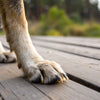How to Stop Your Dog from Jumping on People: A Comprehensive Guide
- Houndsy
Table of Contents
- Introduction
- Understanding the Behavior
- Effective Training Techniques
- Managing Interactions with Others
- Conclusion
- FAQ
Introduction
Did you know that approximately 70% of dog owners report their pets jumping on people as a common annoyance? For many of us, the joy of coming home to a wagging tail can quickly turn into chaos when our furry friends leap up, leaving dirty paw prints and risking injury to unsuspecting guests. Understanding how to stop a dog from jumping on people is not just about preventing a nuisance; it's about fostering better behavior and building a more harmonious relationship between our pets and the people around us.
In this blog post, we will explore the reasons behind this jumping behavior and equip you with effective, practical strategies to curb it. We'll delve into training techniques, the importance of consistency, and how to manage greetings in a way that feels rewarding for your dog. By the end of this article, you will have a comprehensive toolkit to help your beloved pet greet people in a more polite and controlled manner.
Join us as we guide you through each step, ensuring that your dog learns to express their excitement without jumping up on others. Let’s create a more enjoyable and safe environment for both your dog and your guests!
Understanding the Behavior
Why Do Dogs Jump?
Jumping is a natural behavior for dogs, rooted in their social instincts. When dogs greet each other, they often jump up as a way of establishing contact and showing excitement. This instinct is particularly strong in puppies, who may not yet understand the boundaries of acceptable greeting behavior. Unfortunately, many owners unknowingly reinforce this habit by giving attention to their jumping dogs, whether through laughter, petting, or even scolding.
The Risks of Jumping
While it may be cute when a small puppy jumps on you, the same behavior can become problematic as your dog grows. Large breeds can unintentionally knock over children or elderly individuals, leading to serious injuries. Moreover, jumping can result in muddy paw prints on clothes and furniture, creating an unwelcoming environment for guests.
The Importance of Training
Training your dog to stop jumping is crucial not only for the safety of your guests but also for the well-being of your pet. A well-behaved dog is more likely to be welcomed in public spaces and around family and friends. Training also strengthens the bond between you and your dog, as it fosters communication and understanding.
Effective Training Techniques
1. Establish Clear Rules
The first step in training your dog is to set clear rules for greetings. Decide whether all four paws should remain on the floor or if sitting is required. Whatever you choose, be consistent. This consistency helps your dog understand what behavior is expected.
2. Ignore the Jumping
When your dog jumps, the most effective response is to ignore them. Avoid eye contact, turn your back, and refrain from speaking until your dog has all four paws on the ground. This teaches your dog that jumping does not bring the desired attention.
3. Reward Calm Behavior
As soon as your dog calms down and has all four paws on the floor, reward them with praise or treats. This reinforces the idea that staying grounded is the way to get your attention. Use a cue word like "yes" or "good" when you offer this reward to create a positive association.
4. Teach an Incompatible Behavior
An effective way to combat jumping is to teach your dog an incompatible behavior, such as sitting. When your dog learns to sit upon greeting, they cannot jump at the same time. Practice this command consistently, rewarding them for sitting when you arrive home or when guests come over.
5. Control Greetings
When guests arrive, manage the environment to support your training. Leash your dog and instruct guests to ignore them until they are calm. You can also ask visitors to give your dog a treat only when they are sitting or remain on the floor. This sets a positive precedent for how your dog should behave during greetings.
6. Use Management Tools
For dogs that struggle with jumping, consider using management tools like baby gates or crates to limit their access to entrances when guests arrive. This way, your dog can still be part of the gathering without the risk of jumping on visitors.
7. Keep It Low-Key
During training, keep greetings calm and low-key. High energy can exacerbate jumping behavior. Instead of exuberantly greeting your dog when you come home, remain calm and composed. Once your dog begins to understand the rules, you can gradually increase your excitement during greetings.
8. Seek Professional Help
If your dog's jumping behavior persists despite your efforts, consider seeking help from a professional dog trainer. They can provide personalized guidance and help you develop a training plan tailored to your dog's specific needs.
Managing Interactions with Others
1. Educate Family and Friends
It's essential that everyone in your household is on the same page regarding your dog's training. Make sure family members and friends understand the rules and do not inadvertently encourage jumping. Inform them to ignore your dog until they are calm and have all four paws on the floor.
2. Communicate with Strangers
When out in public, communicate with strangers about your dog's training. Politely ask them to refrain from engaging with your dog until they are calm. This helps establish boundaries and supports your training efforts.
3. Use a 'Place' Command
Training your dog to go to a designated spot, such as a mat or bed, can be an effective way to manage their behavior when visitors arrive. Teach your dog to go to this spot and reward them for staying there while guests enter your home.
4. Consistency Is Key
Consistency is crucial throughout the training process. Ensure that everyone who interacts with your dog uses the same commands and rewards. Mixed signals can confuse your dog and hinder their progress.
Conclusion
Learning how to stop your dog from jumping on people requires patience, consistency, and positive reinforcement. By establishing clear rules, managing interactions, and rewarding calm behavior, we can help our furry friends develop better greeting habits that make them more enjoyable companions.
As you embark on this training journey, remember that every dog is different, and some may require more time than others. Celebrate small victories and remain committed to the process. With our guidance and your dedication, your dog can transform from an enthusiastic jumper to a well-mannered companion who knows how to greet others appropriately.
If you want to enhance your dog’s daily experience further, consider exploring our flagship product, the Houndsy Kibble Dispenser. Not only does it simplify feeding, but it also supports your dog's overall well-being by ensuring consistent portion control.
FAQ
Why does my dog jump on people?
Dogs typically jump on people to seek attention and express excitement. It’s a natural social behavior, especially when they’re greeting someone.
How long will it take to train my dog to stop jumping?
The duration of training varies based on individual dogs and their history. Some may learn quickly, while others may take weeks or even months to fully grasp the new behavior.
Can I use negative reinforcement to stop my dog from jumping?
Negative reinforcement is not recommended, as it can lead to fear and anxiety in your dog. Instead, focus on positive reinforcement and redirecting their behavior.
What if my dog only jumps on certain people?
If your dog only jumps on certain individuals, ensure that those people understand the training process and consistently ignore the jumping. Reinforce calm behavior when they greet those guests.
Is it okay for my dog to jump on me?
While some owners may tolerate jumping from their own dogs, it's best to discourage this behavior to maintain consistency and prevent it from becoming a habit that extends to others. Teaching your dog to greet you calmly will benefit all interactions.
By following these guidelines, we can help our dogs learn how to greet others in a way that is respectful and enjoyable for everyone involved. Together, we can create a positive environment for our pets and the people around them!












